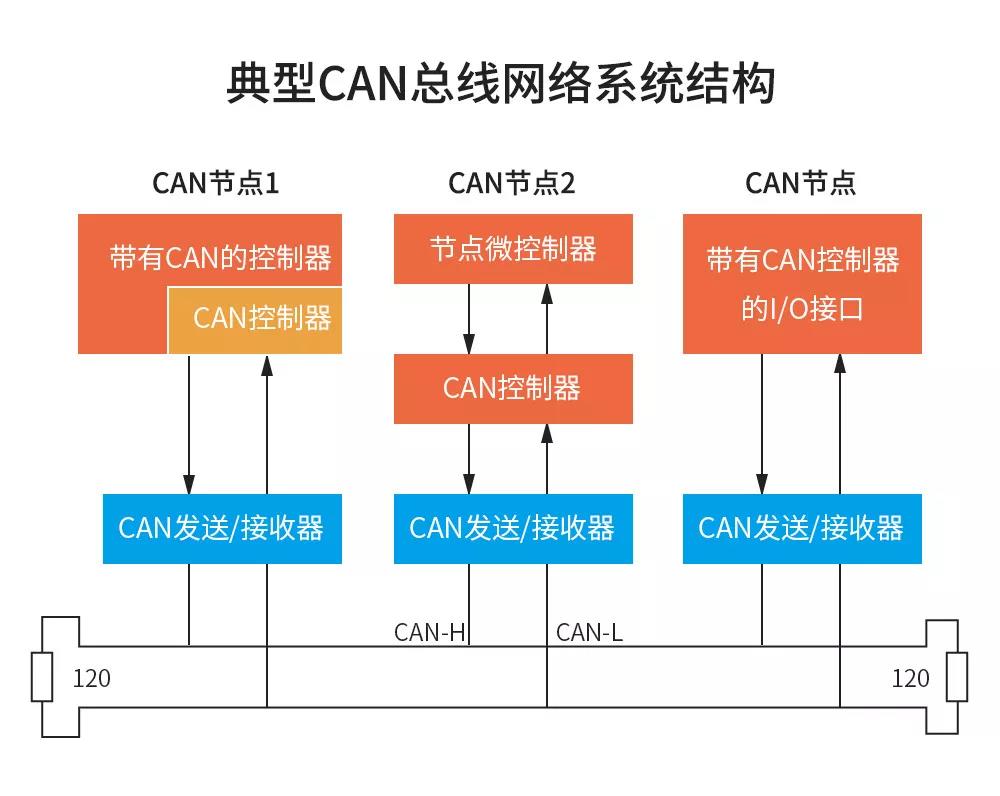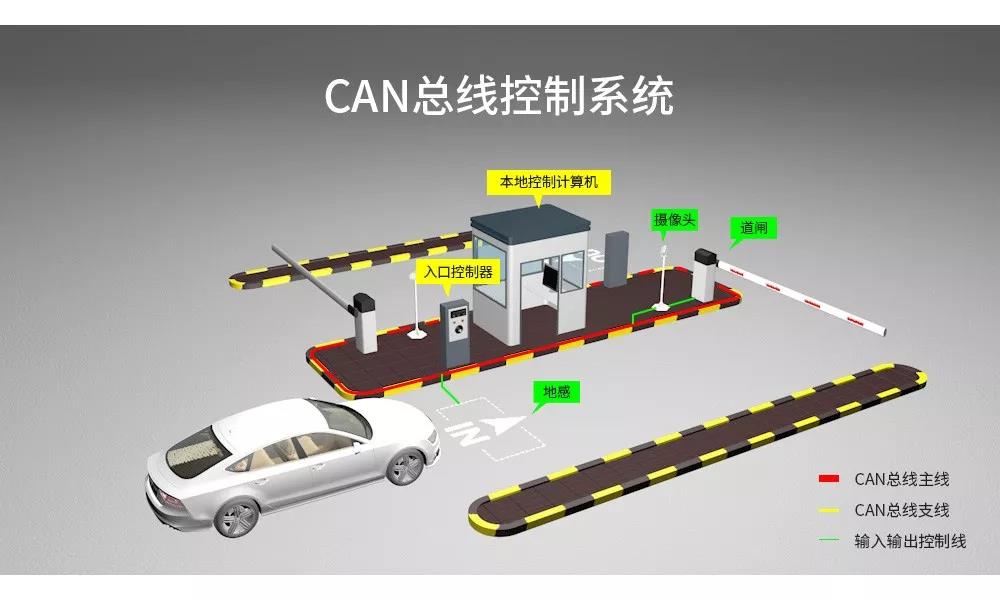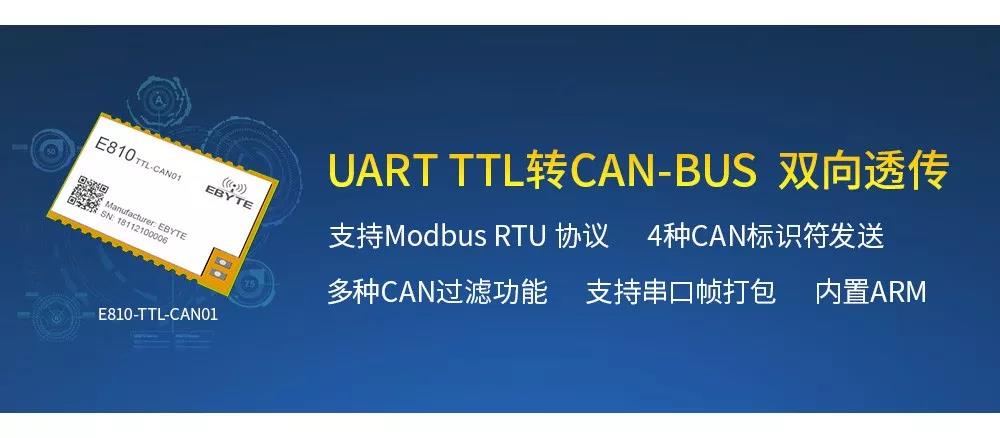
CAN is called "ControllerAreaNetwork", short for CAN, it is one of the most widely used fieldbus in the world. In the current automobile industry, a variety of electronic control systems have been developed to meet the requirements of safety, comfort, convenience, low pollution and low cost. Due to the different data types and reliability requirements for communication between these systems, the number of wire harnesses increases due to the complexity of multiple buses. In order to meet the demand of "reducing the number of wire harnesses" and "high - speed communication of large amounts of data through multiple lans", German electrical manufacturer Bosch developed CAN communication protocol for automobile in 1986. Since then, CAN has been standardized through IS011898 and is011519, and has become the standard protocol of automobile network in Europe. The high performance and reliability of CAN have been recognized and widely used in industrial automation, ships, medical equipment, industrial equipment and other aspects.
CAN bus features

1. CAN is a kind of multi - master bus, that is, each node machine CAN become the host and they CAN communicate with each other.
2. In terms of hardware, the communication medium can be twisted pair cable, coaxial cable or optical fiber, and the communication rate can reach 1mb/s.
3. The CAN bus communication interface integrates the physical layer and data link layer functions of CAN protocol to complete frame processing of communication data, including bit filling, data block coding, cyclic redundancy check, priority discrimination and other work.
4. One of the biggest features of CAN protocol is that it abolishes the traditional station address coding and encodes from the communication data block instead. Using the advantage of this approach is can make the network node number is not restricted in theory, data block identification code can be made of 11 or 29 of binary Numbers, so you can define 211 or 229 different data block, this block coding way, still can make different node receives the same data at the same time, which is very important in the control step by step.
5. The length of data segment is up to 8 bytes, which can meet the general requirements of control command, working state and test data in common industrial fields. At the same time, 8 bytes will not occupy the bus for too long, thus ensuring the real-time communication.
6. CAN protocol adopts CRC test and CAN provide corresponding error processing function to ensure the reliability of data communication. CAN bus has extremely high reliability and unique design, especially suitable for the interconnection of industrial measurement and control units. Industry's position cannot be underestimated, and has been recognized as one of the most promising fieldbus.
The working principle of CAN bus
CAN bus USES serial data transmission mode, CAN run at 1Mb/s rate on 40m twisted pair, CAN also use optical cable connection, and the bus protocol supports multiple master controllers on this bus. CAN is similar to the I2C bus in many details, but there are some obvious differences.

When a node (station) on the CAN bus sends data, it broadcasts it as a message to all nodes in the network. For each node, all data is received. Each set of messages begins with an 11 - bit character identifier that defines the priority of the message in a format called content oriented addressing scheme. Identifiers are unique in the same system, and it is impossible for two stations to send messages with the same identifier. This configuration is important when several stations are competing for bus reads at the same time.
When a station wants to send data to other stations, the CPU of the station will send data and its own identifier to the CAN chip of the station, and is in a ready state; When it receives a bus assignment, it goes to send message state. The CAN chip organizes the data into a certain message format according to the protocol and sends it out, while other stations on the network are in the receiving state. Each station in the receiving state detects the incoming messages and determines whether they are sent to itself to receive them or not.
Because CAN bus is a content - oriented addressing scheme, it is easy to set up a high level control system and configure it flexibly. So it is very convenient to add some new stations in CAN bus without any modification in hardware or software. When the provided new station is a pure data receiving device, the data transmission protocol does not require the independent part to have a physical destination address. It allows synchronization of the distribution process, that is, when the controller on the bus needs to measure data, it can be obtained from the network, without each controller having its own independent sensor.
Advantages of CAN bus
1. High performance: it has the advantages of strong real - time performance, long transmission distance, strong anti - electromagnetic interference ability and low cost.
2. Anti - interference: dual - line serial communication mode is adopted, with strong error correction ability, and it can work in high - noise and multi - interference environment;
3. High integration: with priority and arbitration functions, multiple control modules CAN be assembled on can - bus through CAN controller, thus forming multi-host local network;
4. Controllability: the ID of the message can be used to decide whether to receive or block the message;
5. Verification and error correction: reliable error handling and error detection mechanism;
6. Repair ability: after the sent information is damaged, it can be automatically retransmitted;
7. Intelligentization: the node can automatically exit the bus in case of serious errors;
8. Security: the message does not contain the source address or the target address, and only USES the identifier to indicate the functional information and priority information.
Disadvantages of CAN bus
1. Possible data inconsistency
2. Unforeseeable errors may occur
3. Channel congestion
Application of CAN bus
1. Building automation
In modern building automation, building installation system (ventilation, lighting, security, monitoring) based on the CAN bus system is more and more, through its real switches, buttons, sensors, lighting equipment, other data exchange between actuator and control system, realize the collaboration between each operating unit in the building, and changing the status of the real-time control of each unit.
2. Security monitoring
In the current monitoring systems, there are many shortcomings, such as low reliability, low real - time performance, and lack of unified standards for sub - stations, which can not well meet the requirements of real - time monitoring. CAN bus CAN well solve the above problems due to its high data transmission rate, perfect specification and protocol, high real-time, security and reliability. It is widely used in hydropower station high slope monitoring system, large remote high slope monitoring network, roller ceramic cellar and other monitoring systems.
3. Automobile industry
In the field of automobile industry, CAN is designed to communicate as a microcontroller in the automobile environment, to exchange information among ECU of various on - board electronic control devices, and to form an automobile electronic control network. For example, CAN control device is embedded in automobile power system, brake control system, gearbox controller, instrument, vehicle network and electronic main system. Its application makes the performance of safety, comfort and power more intelligent and modern. Now CAN's high performance and reliability has been recognized, and is widely used in industrial automation, ships, medical equipment, industrial equipment and other aspects, CAN bus in today's rapid growth in the field of automation, known as the field of automation computer LAN. It realizes real - time and reliable data communication between nodes of distributed control system.

E810 - ttl - can01, a wireless communication product targeted at CAN BUS scheme, will be launched by yibaite in the near future. This product realizes the mutual transparent transmission between uart - ttl and can - bus. ModBuS RTU protocol, 4 identifier transmission, serial frame data packaging and 8 CAN data filtering, built - in ARM and other practical features. The high quality and performance of e810 - ttl - can01 provides strong support for automotive industry, safety monitoring, equipment automation and other fields. Stay tuned!